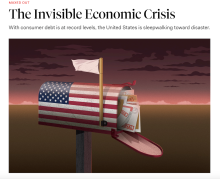While Americans are falling behind on their bills at record levels and the United States is teetering on an economic crisis, UW Sociologist Sarah Quinn is sharing her knowledge and research on the history of the credit welfare state to try to help explain an often complex issue in a recent article The Invisible Economic Crisis in The New Republic.
While the article lives behind a firewall for most, her quote is especially timely and relevant to our current economic situation.
“We have a really flimsy welfare state to begin with,” says Sarah Quinn. “That’s absolutely under attack in the current political environment.” Quinn points to what scholars call the credit welfare state trade-off, where weak public benefits are offset by policies that expand access to private credit. The result is that households end up borrowing to cover costs like housing, education, and health care.
Her previous research and discussions on this topic dive even deeper. In credit markets, people convert their social status and resources into actual cash at different rates. In the context of white supremacy, this has always benefited white people. In the context of patriarchy, this has benefited men. In the context of militarism, this has benefited soldiers. When governments get involved, these inequalities can be magnified. This won’t be news to sociologists. Stratification scholars have long shown that housing credit programs like the FHA and Home Owners’ Loan Corporation are engines of racial inequality, and that white borrowers are the big winners in U.S. credit markets relative to other groups.
Beyond that, who wins and loses depends on the time, place and policy. Credit is a part of any political economy, and people need access to credit for a variety of reasons. Today wages are low, inequality is high, regulations are shredded, and many people are forced to borrow large amounts – at exorbitated rates if they are poor – to meet basic needs like housing, transportation, education, and healthcare. That is bad for anyone who isn’t wealthy, catastrophic for poor families, and lenders are the big winners. For earlier periods, the story is more complex.
To learn more about Sarah Quinn’s research on the history of the federal government’s use of credit as an inequitable policy tool, read HERE.
